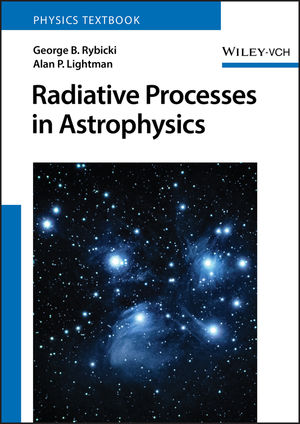Radiative Processes in AstrophysicsISBN: 978-0-471-82759-7
Paperback
400 pages
January 1991
 This is a Print-on-Demand title. It will be printed specifically to fill your order. Please allow an additional 10-15 days delivery time. The book is not returnable.
|
||||||
Chapter 1
Fundamentals of Radiative Transfer
1.1 The Electromagnetic Spectrum;
Elementary Properties of Radiation
1.2 Radiative Flux
1.3 The Specific Intensity and Its Moments
1.4 Radiative Transfer
1.5 Thermal Radiation
1.6 The Einstein Coefficients
1.7 Scattering Effects;
Random Walks
1.8 Radiative Diffusion
Chapter 2
Basic Theory of Radiation Fields
2.1 Review of Maxwell's Equations
2.2 Plane Electromagnetic Waves
2.3 The Radiation Spectrum
2.4 Polarization and Stokes Parameters 62
2.5 Electromagnetic Potentials
2.6 Applicability of Transfer Theory and the Geometrical Optics Limit
Chapter 3
Radiation from Moving Charges
3.1 Retarded Potentials of Single Moving Charges: The Liénard-Wiechart Potentials
3.2 The Velocity and Radiation Fields
3.3 Radiation from Nonrelativistic Systems of Particles
3.4 Thomson Scattering (Electron Scattering)
3.5 Radiation Reaction
3.6 Radiation from Harmonically Bound Particles
Chapter 4
Relativistic Covariance and Kinematics
4.1 Review of Lorentz Transformations
4.2 Four-Vectors
4.3 Tensor Analysis
4.4 Covariance of Electromagnetic Phenomena
4.5 A Physical Understanding of Field Transformations 129
4.6 Fields of a Uniformly Moving Charge
4.7 Relativistic Mechanics and the Lorentz Four-Force
4.8 Emission from Relativistic Particles
4.9 Invariant Phase Volumes and Specific Intensity
Chapter 5
Bremsstrahlung
5.1 Emission from Single-Speed Electrons
5.2 Thermal Bremsstrahlung Emission
5.3 Thermal Bremsstrahlung (Free-Free) Absorption
5.4 Relativistic Bremsstrahlung
Chapter 6
Synchrotron Radiation
6.1 Total Emitted Power
6.2 Spectrum of Synchrotron Radiation: A Qualitative Discussion
6.3 Spectral Index for Power-Law Electron Distribution
6.4 Spectrum and Polarization of Synchrotron Radiation: A Detailed Discussion
6.5 Polarization of Synchrotron Radiation
6.6 Transition from Cyclotron to Synchrotron Emission
6.7 Distinction between Received and Emitted Power
6.8 Synchrotron Self-Absorption
6.9 The Impossibility of a Synchrotron Maser in Vacuum
Chapter 7
Compton Scattering
7.1 Cross Section and Energy Transfer for the Fundamental Process
7.2 Inverse Compton Power for Single Scattering
7.3 Inverse Compton Spectra for Single Scattering
7.4 Energy Transfer for Repeated Scatterings in a Finite, Thermal Medium: The Compton Y Parameter
7.5 Inverse Compton Spectra and Power for Repeated Scatterings by Relativistic Electrons of Small Optical Depth
7.6 Repeated Scatterings by Nonrelativistic Electrons: The Kompaneets Equation
7.7 Spectral Regimes for Repeated Scattering by Nonrelativistic Electrons
Chapter 8
Plasma Effects
8.1 Dispersion in Cold, Isotropic Plasma
8.2 Propagation Along a Magnetic Field;
Faraday Rotation
8.3 Plasma Effects in High-Energy Emission Processes
Chapter 9
Atomic Structure
9.1 A Review of the Schrödinger Equation
9.2 One Electron in a Central Field
9.3 Many-Electron Systems
9.4 Perturbations, Level Splittings, and Term Diagrams
9.5 Thermal Distribution of Energy Levels and Ionization
Chapter 10
Radiative Transitions
10.1 Semi-Classical Theory of Radiative Transitions
10.2 The Dipole Approximation
10.3 Einstein Coefficients and Oscillator Strengths
10.4 Selection Rules
10.5 Transition Rates
10.6 Line Broadening Mechanisms
Chapter 11
Molecular Structure
11.1 The Born-Oppenheimer Approximation: An Order of Magnitude Estimate of Energy Levels
11.2 Electronic Binding of Nuclei
11.3 Pure Rotation Spectra
11.4 Rotation-Vibration Spectra
11.5 Electronic-Rotational-Vibrational Spectra
Solutions
Index
Fundamentals of Radiative Transfer
1.1 The Electromagnetic Spectrum;
Elementary Properties of Radiation
1.2 Radiative Flux
1.3 The Specific Intensity and Its Moments
1.4 Radiative Transfer
1.5 Thermal Radiation
1.6 The Einstein Coefficients
1.7 Scattering Effects;
Random Walks
1.8 Radiative Diffusion
Chapter 2
Basic Theory of Radiation Fields
2.1 Review of Maxwell's Equations
2.2 Plane Electromagnetic Waves
2.3 The Radiation Spectrum
2.4 Polarization and Stokes Parameters 62
2.5 Electromagnetic Potentials
2.6 Applicability of Transfer Theory and the Geometrical Optics Limit
Chapter 3
Radiation from Moving Charges
3.1 Retarded Potentials of Single Moving Charges: The Liénard-Wiechart Potentials
3.2 The Velocity and Radiation Fields
3.3 Radiation from Nonrelativistic Systems of Particles
3.4 Thomson Scattering (Electron Scattering)
3.5 Radiation Reaction
3.6 Radiation from Harmonically Bound Particles
Chapter 4
Relativistic Covariance and Kinematics
4.1 Review of Lorentz Transformations
4.2 Four-Vectors
4.3 Tensor Analysis
4.4 Covariance of Electromagnetic Phenomena
4.5 A Physical Understanding of Field Transformations 129
4.6 Fields of a Uniformly Moving Charge
4.7 Relativistic Mechanics and the Lorentz Four-Force
4.8 Emission from Relativistic Particles
4.9 Invariant Phase Volumes and Specific Intensity
Chapter 5
Bremsstrahlung
5.1 Emission from Single-Speed Electrons
5.2 Thermal Bremsstrahlung Emission
5.3 Thermal Bremsstrahlung (Free-Free) Absorption
5.4 Relativistic Bremsstrahlung
Chapter 6
Synchrotron Radiation
6.1 Total Emitted Power
6.2 Spectrum of Synchrotron Radiation: A Qualitative Discussion
6.3 Spectral Index for Power-Law Electron Distribution
6.4 Spectrum and Polarization of Synchrotron Radiation: A Detailed Discussion
6.5 Polarization of Synchrotron Radiation
6.6 Transition from Cyclotron to Synchrotron Emission
6.7 Distinction between Received and Emitted Power
6.8 Synchrotron Self-Absorption
6.9 The Impossibility of a Synchrotron Maser in Vacuum
Chapter 7
Compton Scattering
7.1 Cross Section and Energy Transfer for the Fundamental Process
7.2 Inverse Compton Power for Single Scattering
7.3 Inverse Compton Spectra for Single Scattering
7.4 Energy Transfer for Repeated Scatterings in a Finite, Thermal Medium: The Compton Y Parameter
7.5 Inverse Compton Spectra and Power for Repeated Scatterings by Relativistic Electrons of Small Optical Depth
7.6 Repeated Scatterings by Nonrelativistic Electrons: The Kompaneets Equation
7.7 Spectral Regimes for Repeated Scattering by Nonrelativistic Electrons
Chapter 8
Plasma Effects
8.1 Dispersion in Cold, Isotropic Plasma
8.2 Propagation Along a Magnetic Field;
Faraday Rotation
8.3 Plasma Effects in High-Energy Emission Processes
Chapter 9
Atomic Structure
9.1 A Review of the Schrödinger Equation
9.2 One Electron in a Central Field
9.3 Many-Electron Systems
9.4 Perturbations, Level Splittings, and Term Diagrams
9.5 Thermal Distribution of Energy Levels and Ionization
Chapter 10
Radiative Transitions
10.1 Semi-Classical Theory of Radiative Transitions
10.2 The Dipole Approximation
10.3 Einstein Coefficients and Oscillator Strengths
10.4 Selection Rules
10.5 Transition Rates
10.6 Line Broadening Mechanisms
Chapter 11
Molecular Structure
11.1 The Born-Oppenheimer Approximation: An Order of Magnitude Estimate of Energy Levels
11.2 Electronic Binding of Nuclei
11.3 Pure Rotation Spectra
11.4 Rotation-Vibration Spectra
11.5 Electronic-Rotational-Vibrational Spectra
Solutions
Index



